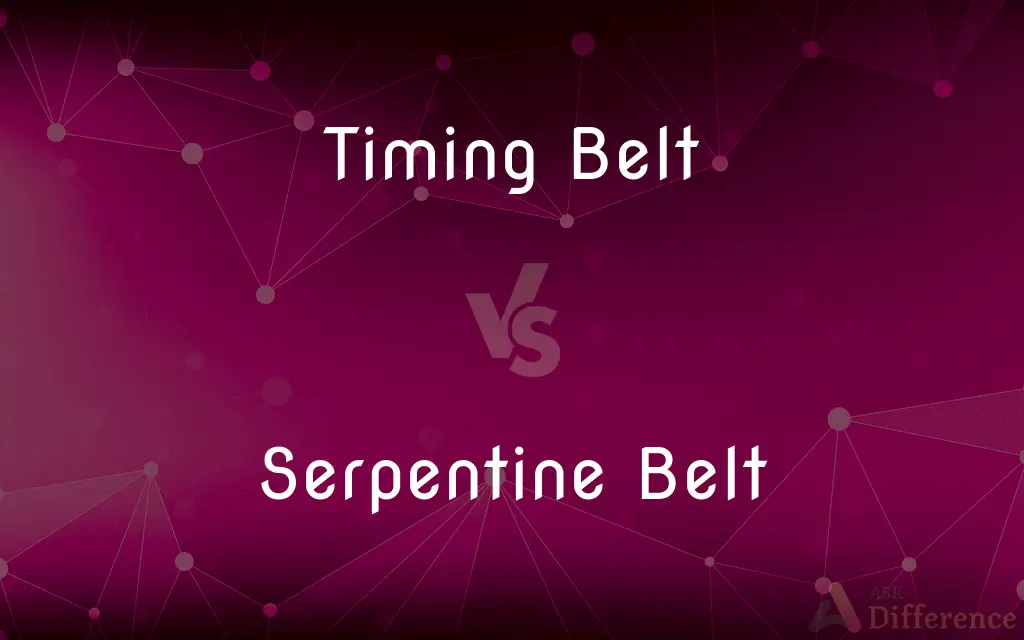Timing Belt vs. Serpentine Belt — What's the Difference?
By Tayyaba Rehman & Urooj Arif — Published on March 21, 2024
A timing belt synchronizes the engine's camshaft and crankshaft, ensuring proper timing of cylinder firing, while a serpentine belt powers peripheral devices like the alternator, power steering pump, and air conditioning.

Difference Between Timing Belt and Serpentine Belt
Table of Contents
ADVERTISEMENT
Key Differences
The timing belt is a crucial component of an engine's internal mechanism, designed to keep the camshaft and crankshaft turning in synchronized motion. This synchronization is vital for the engine's valves to open and close at the correct times during each cylinder's intake and exhaust strokes. Without a properly functioning timing belt, the engine could suffer severe damage due to the pistons and valves colliding.
The serpentine belt, also known as a drive belt, plays a key role in the external operation of the engine. It transfers power from the engine's crankshaft to various peripherals, including the alternator, power steering pump, water pump, and air conditioning compressor. Unlike the timing belt, the serpentine belt is visible on the outside of the engine and is easily accessible for inspection and replacement.
Timing belts are typically made of rubber with high-tensile fibers and need to be replaced at specific intervals, usually between 60,000 and 100,000 miles, to prevent failure. Failure of the timing belt can lead to catastrophic engine damage. Serpentine belts, while also made of durable rubber compounds, tend to have a longer lifespan but should still be inspected regularly for wear and tear.
The design of the timing belt is such that it can precisely control the timing of the engine's valves without slipping. The serpentine belt, in contrast, is designed for flexibility and durability to efficiently manage the varying loads from the different accessories it drives. The tensioner and idler pulleys help maintain the serpentine belt's tension and alignment.
Both the timing belt and serpentine belt are vital to a car's operation, but they serve distinctly different functions. The timing belt ensures the engine runs smoothly by keeping internal parts synchronized, whereas the serpentine belt powers the engine's external accessories. Regular maintenance and timely replacement of these belts are crucial to the vehicle's performance and longevity.
ADVERTISEMENT
Comparison Chart
Function
Synchronizes camshaft and crankshaft
Drives peripheral devices like alternator, AC compressor
Location
Inside the engine, covered
Outside the engine, visible
Material
Rubber with high-tensile fibers
Durable rubber compound
Replacement Interval
60,000 to 100,000 miles
Varies, often longer than timing belt
Failure Consequences
Can cause severe engine damage
May lead to loss of power steering, alternator, or AC
Compare with Definitions
Timing Belt
Requires periodic replacement to prevent breaking.
The mechanic recommended changing the timing belt every 75,000 miles.
Serpentine Belt
Uses tensioners for proper tension and alignment.
The mechanic adjusted the tensioner to ensure the serpentine belt was tight enough.
Timing Belt
Critical for engine performance and avoidance of piston damage.
A snapped timing belt could lead to costly repairs due to piston and valve collisions.
Serpentine Belt
Has a longer lifespan but should be checked regularly.
Despite its durability, the serpentine belt needs regular inspection for wear.
Timing Belt
Specifically designed for the engine's timing needs.
Timing belts are engineered to meet precise engine timing requirements.
Serpentine Belt
A long belt that powers engine peripherals.
The serpentine belt was replaced to restore power to the alternator.
Timing Belt
A belt that maintains the timing between the crankshaft and camshaft.
He replaced the timing belt to avoid potential engine damage.
Serpentine Belt
Visible on the engine's exterior and drives multiple accessories.
You can see the serpentine belt looped around the alternator and AC compressor.
Timing Belt
Made from rubber and high-tensile fibers for durability.
The timing belt's high-tensile fibers ensure it can withstand engine forces.
Serpentine Belt
Made for flexibility and to withstand various loads.
The serpentine belt's design allows it to flex under load without breaking.
Common Curiosities
What happens if a timing belt breaks?
A broken timing belt can cause the engine to stop running and potentially lead to severe engine damage, including bent valves and damaged pistons.
Is it expensive to replace a timing belt?
Timing belt replacement can be costly due to the labor-intensive process and the potential need to remove parts of the engine to access the belt.
Can I replace a serpentine belt myself?
If you have mechanical knowledge and the right tools, you can replace a serpentine belt, but ensure you understand the routing and tensioning requirements.
Can a worn serpentine belt affect fuel efficiency?
Yes, because it can affect the performance of the alternator and, subsequently, the electrical system, including the fuel injection system.
Can a car run without a serpentine belt?
A car might run temporarily without a serpentine belt, but it will lose functionality of essential components like the alternator and power steering, leading to battery drain and difficult steering.
Why is the serpentine belt called 'serpentine'?
It's called 'serpentine' because it snakes around the various pulleys in a complex path.
What are the consequences of not replacing a serpentine belt?
Not replacing a worn serpentine belt can lead to loss of vehicle accessories, overheating, and potential battery drain.
What are signs of a worn serpentine belt?
Signs include squealing noises, visible wear like cracks or fraying, and accessories like the power steering or alternator not functioning properly.
Do all cars have both a timing belt and a serpentine belt?
Most cars will have either a timing belt or a timing chain, and a serpentine belt. Some engines use a timing chain instead of a belt for camshaft-crankshaft synchronization.
How often should I replace my timing belt?
Generally, replace your timing belt every 60,000 to 100,000 miles, but consult your vehicle's manual for specific recommendations.
How can I tell if my timing belt needs replacement?
Look for signs like difficulty starting the engine, a ticking noise from the engine, or the engine misfiring. Regular maintenance checks are also crucial.
What's the difference between a timing belt and a timing chain?
A timing chain performs the same function as a timing belt but is made of metal and generally lasts longer, though it may require more maintenance for its associated parts.
What tools are needed to replace a serpentine belt?
Basic tools include a ratchet or wrench set and a serpentine belt tool or long-handled socket wrench to release the tensioner.
Is it common for timing belts to break?
With regular maintenance and timely replacement, it's not common, but neglecting replacement can lead to a higher risk of breaking.
Can a failing serpentine belt cause overheating?
Yes, if the belt drives the water pump and it fails, it can lead to engine overheating.
Share Your Discovery

Previous Comparison
Estate Sale vs. Garage Sale
Next Comparison
Atomic Spectroscopy vs. Molecular SpectroscopyAuthor Spotlight
Written by
Tayyaba RehmanTayyaba Rehman is a distinguished writer, currently serving as a primary contributor to askdifference.com. As a researcher in semantics and etymology, Tayyaba's passion for the complexity of languages and their distinctions has found a perfect home on the platform. Tayyaba delves into the intricacies of language, distinguishing between commonly confused words and phrases, thereby providing clarity for readers worldwide.
Co-written by
Urooj ArifUrooj is a skilled content writer at Ask Difference, known for her exceptional ability to simplify complex topics into engaging and informative content. With a passion for research and a flair for clear, concise writing, she consistently delivers articles that resonate with our diverse audience.














































